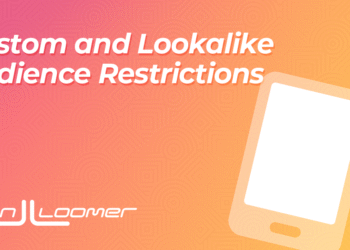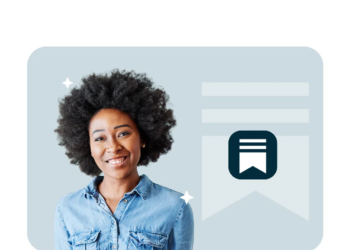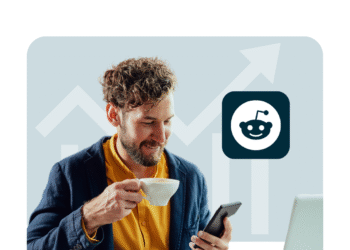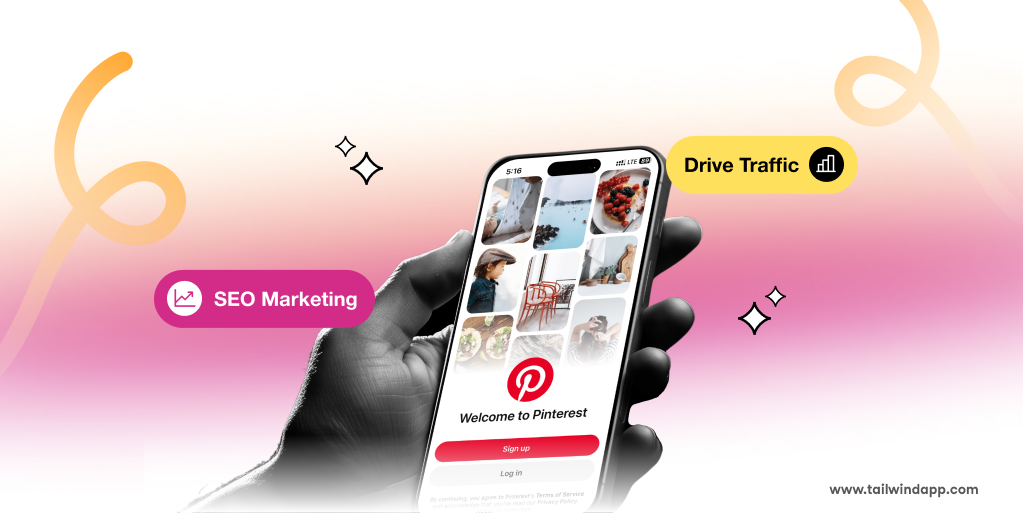
If you’ve been wondering whether Pinterest actually helps with SEO, you’re not alone. I get this question constantly from bloggers and business owners who want to know if all those hours spent creating Pins are actually moving the needle for their search rankings.
The short answer? Pinterest absolutely helps with SEO — just not in the direct way you might think. Let me break down exactly how Pinterest works as an SEO powerhouse and why you should definitely be using it as part of your overall search strategy.
What Is Pinterest SEO?
Pinterest SEO is all about optimizing your Pins, boards, and profile to get discovered both within Pinterest’s search engine and on Google. Here’s what makes Pinterest unique: it’s simultaneously a visual discovery platform AND a legitimate search engine that Google actually crawls and indexes.
When you optimize for Pinterest SEO, you’re essentially creating keyword-rich content that can drive sustained referral traffic to your website for months and even years. Unlike other social platforms where your content disappears into the void after a few hours, Pinterest content has serious staying power.
Think of Pinterest as the bridge between social media and Google search. Your Pins can rank in both Pinterest’s internal search results and Google’s image search, giving you double the exposure for your content.
If you’re looking to streamline your Pinterest content creation process, tools like the Tailwind Extension can help you efficiently create and schedule fresh Pins from your own website content.
And Tailwind SmartPin will create a brand new keyword-optimized Pin for your blog and product pages every week. Drop in the URL, then approve and schedule Pins — it’s that easy.
Can Pinterest Drive Google SEO Benefits?
This is where things get interesting. Pinterest links are “nofollow,” which means they don’t pass direct link juice to your website for SEO purposes. But that doesn’t mean Pinterest is useless for your Google rankings — far from it!
Here’s what actually happens: Google crawls and indexes Pinterest content, including your Pins, boards, and profile. This means your Pinterest content can actually show up in Google search results. I’ve seen Pinterest boards ranking on the first page of Google for competitive keywords like “DIY bedroom makeover” and “healthy meal prep ideas.”

Pinterest also dominates Google’s image search results. When someone searches for visual content on Google, Pinterest Pins often take up a significant portion of the first page. This gives you incredible brand visibility and can drive serious traffic back to your site.
Plus, Pinterest helps with what SEO experts call “brand SERPs”: when someone searches for your brand name on Google, your Pinterest profile and boards often show up prominently, giving you more real estate on that first page of results.
Pinterest as a Traffic Engine for Your Site
Here’s where Pinterest really shines for SEO: it’s basically a traffic generation machine that keeps working for you long after you hit publish. According to Tailwind’s 2025 research analyzing over 1 million Pins, over 60% of saves were from Pins over a year old, and over 40% were from Pins over two years old.
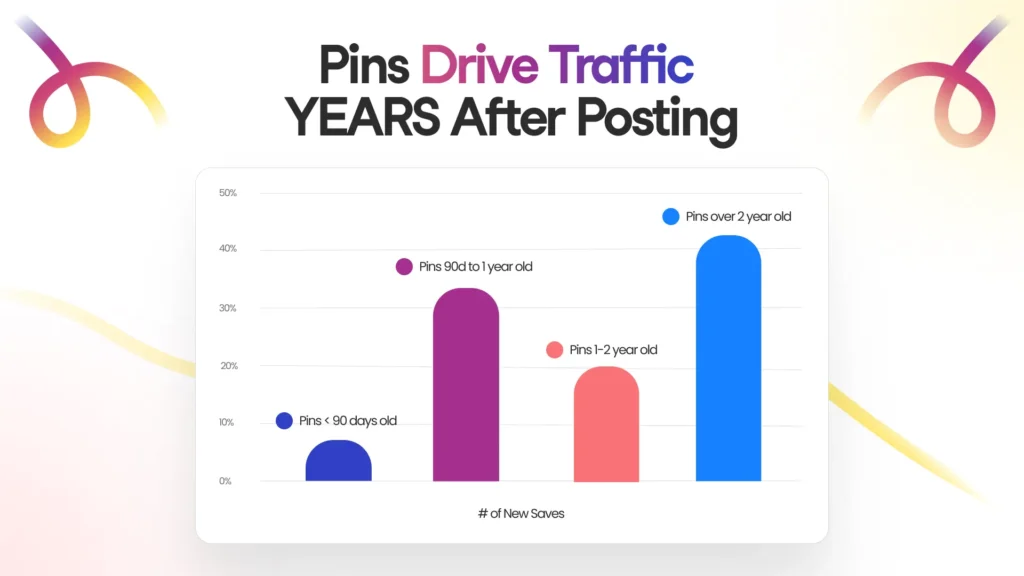
Let that sink in for a minute. Your content can continue driving traffic and engagement for literally years — something that’s virtually impossible on platforms like Instagram or Facebook where posts have a lifespan of hours or days at most.
This long-term traffic generation is gold for SEO because it means:
- Consistent referral traffic signals to Google that your content is valuable
- More opportunities for people to link to your content naturally
- Increased brand awareness and direct searches for your business
How Pinterest Boards Help Organize & Amplify SEO
Your Pinterest boards are basically keyword-optimized landing pages that can rank in search results. When you create boards with strategic names and descriptions, you’re essentially creating topical authority around specific keywords.
For example, if you have a food blog, creating boards like “30-Minute Healthy Dinners” or “Gluten-Free Dessert Recipes” helps establish your expertise in those specific niches. These boards can rank in both Pinterest and Google search results, driving targeted traffic to your content.
The way Pinterest’s algorithm works is particularly interesting for SEO. When you pin your content to relevant boards it helps Pinterest understand the context of your content. The more you add fresh Pins for your content to relevant boards, the more Pinterest will show your content to people interested in that topic.
Common Pinterest SEO Mistakes to Avoid
Before we get into best practices, let me save you from the mistakes I see people making constantly:
Keyword stuffing in Pin descriptions. Yes, keywords matter, but Tailwind’s 2025 research shows that the most viral Pins actually had shorter descriptions (averaging 220-232 characters). Focus on one main keyword per Pin rather than trying to stuff in everything.
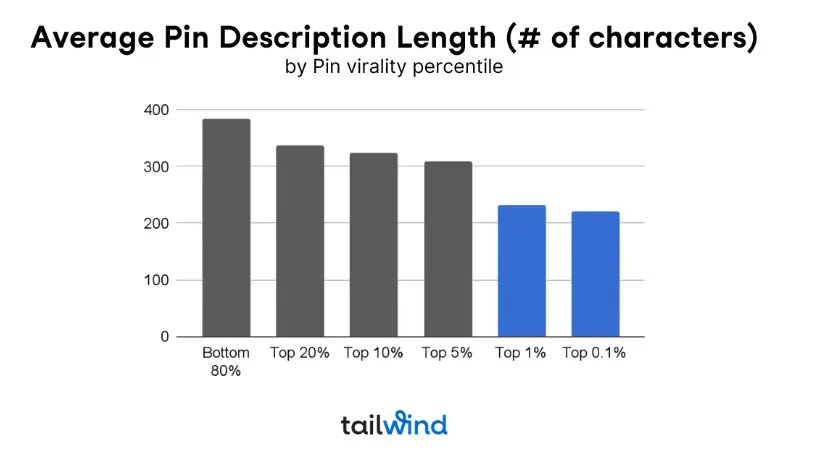
Using irrelevant board names. Your board names should be clear, keyword-rich, and directly related to the content you’re pinning. Avoid cute names that don’t tell Pinterest (or potential followers) what the board is about.
Ignoring Pin titles. Pin titles are still visible in feeds (at least the first 35-45 characters), and they’re crucial for Pinterest SEO. The research found that viral Pins consistently used target keywords in their titles.
Getting the image specs wrong. Pinterest strongly favors vertical images, and the data proves it. Use a 2:3 aspect ratio and aim for 1000 pixels wide by 1500 pixels tall. Horizontal or square images just don’t perform as well in Pinterest’s algorithm.
Pinterest SEO Best Practices for 2025
Based on the latest research and what’s actually working right now, here are the strategies you need to implement:
Use Pinterest Trends for keyword research. Pinterest Trends shows you what people are actually searching for on the platform, giving you real-time insights into trending keywords in your niche.
Create new Pins consistently. The research is crystal clear on this: over 90% of traffic to creator websites comes from new Pins (not saves of existing content). Pinterest heavily favors original content, so focus on creating new Pins rather than just re-pinning existing content.
Optimize your Pin text elements. Use your target keyword in the Pin title, include it naturally in the description, and add keyword-rich alt text.
Focus on vertical image Pins. The research found that 89% of the most viral Pins were image Pins (not video), and vertical formatting still dominates. Don’t feel like you need to create complex video content — high-quality vertical images are your best bet.
Schedule strategically. Tailwind’s research found that Pins published through their scheduling platform were up to 54% more likely to drive high volumes of traffic. The key is posting consistently when your audience is most active. Tailwind recommends posting times based on your account’s data, and these can be adjusted as you learn what works for your specific audience.
Final Verdict: Is Pinterest Good for SEO?
Absolutely yes. Pinterest is fantastic for SEO, just not in the traditional “link building” sense. Here’s the bottom line:
Pinterest drives long-term referral traffic that signals to Google that your content is valuable and worth ranking. It helps you dominate visual search results and claim more real estate on brand search results pages. Plus, Pinterest content itself can rank in Google search results, giving you additional opportunities to be found.
The key is understanding that Pinterest SEO is a long-term strategy. You’re not going to see immediate results like you might with Google Ads, but the compound effect of consistent pinning can be absolutely game-changing for your organic traffic.
My recommendation? Use Pinterest SEO as part of a comprehensive search strategy alongside your traditional Google SEO efforts. The platforms complement each other beautifully, and the traffic you’ll get from Pinterest will only strengthen your overall SEO performance.
FAQ Section
Q: Does Pinterest provide ‘dofollow’ backlinks for SEO?
A: No. Pinterest uses ‘nofollow’ links, which means they don’t pass direct “link juice” to your website. However, these links are still crawlable by Google and provide valuable referral traffic and brand signals that can indirectly benefit your SEO.
Q: Can Pinterest content rank on Google?
A: Yes! Pinterest Pins, boards, and profiles can all rank in Google search results. This is especially common for visual searches and brand-related queries. I regularly see Pinterest boards ranking on the first page of Google for competitive keywords.
Q: Should I use hashtags on Pinterest for SEO?
A: Hashtags aren’t necessary for Pinterest SEO success. The 2025 research shows that only 19% of viral Pins used hashtags, and when they did, Pinterest likely interpreted them as regular keywords anyway. Focus on natural keyword usage in your descriptions instead.
Q: How many times should I pin per week?
A: Quality and consistency matter more than sheer volume. The research shows that success is partly a numbers game (the top 1% of Pins drive 50% of all traffic), but focus on creating fresh, high-quality Pins consistently. Tailwind recommends posting times based on your specific account data to maximize reach.
Q: What’s the difference between saves and fresh Pins?
A: Saves are when someone saves an existing Pin to their board (like sharing), while fresh Pins are brand new content you create. The research is clear: Most traffic to your website traffic comes from newly created Pins, not saves. Pinterest heavily favors original content in their algorithm.
Q: How long does it take to see results from Pinterest SEO?
A: Pinterest is a long-term strategy. While some Pins might get traction immediately, the research shows that viral Pins typically peak between year one and two. Many Pins continue driving meaningful traffic for years, making Pinterest more similar to Google search than traditional social media in terms of content longevity.
Q: Do I need professional photography for Pinterest SEO?
A: Not necessarily! The research found that you can succeed with various levels of photo quality. However, if your photography is more amateur-level, you might want to enhance it with designed Pin images using tools like Tailwind Create rather than relying on raw photos alone.
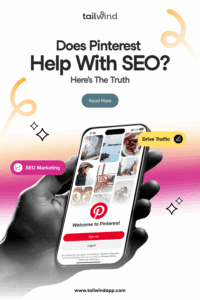
The post Does Pinterest Help with SEO? Here’s the Truth. appeared first on Tailwind Blog.

